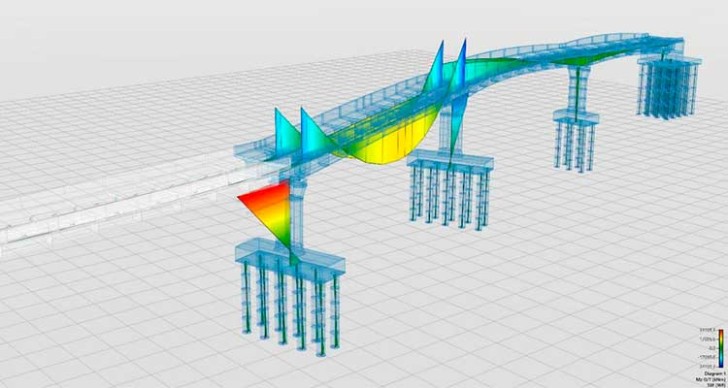As we have explained in several articles in this blog, the Building Information Modeling methodology is a process that is used for the planning and construction of buildings and other infrastructure.
You may wonder how we can categorize the
BIM as a tool used for planning and implementing a project, when in fact it is used in a pre-construction phase. Actually,
BIM Modeling or any Virtual Design Building process is not limited to a single phase, but has a seamless approach and
can be used in multiple construction phases. Construction companies, architectural firms, general contractors, and many other agents already use BIM modeling on a daily basis, although its application in the civil field is not yet massive. Structures such as bridges, roads, tunnels are still using less technology. However, civil structures such as bridges are more complex and
require a lot of analysis along with good design validation. Whether it’s a new project or a renovation or reconstruction of older bridges, in both cases, BIM can help project stakeholders plan, collaborate, and implement the overall construction.
Factors to consider when building a bridge
When building bridges, it is important to focus on the
general geological conditions, location references, proximity to water, and future use. Calculation of loads, pressure, checking the connectivity to cities, rainfall, footfalls on the bridge, transport movement, etc. should be
validated and checked before design. After the design stage, we can definitely rely on Virtual Construction modeling to ensure that the designs and calculations are good for construction. The
number of vehicles crossing the bridge should be the determining factor for the load calculations. Traffic intensity and peak traffic times must be taken into account. If the bridge is connecting two ends of a river, it needs to be stronger taking into account the river flow and current. Let's talk about the use of BIM services in two scenarios:
BIM for new bridge construction
The design of the virtual construction of a bridge is different from other structures or buildings. The purpose and use are very different. Therefore, the use of BIM is also different. In this type of construction, there is a need to build a detailed 3D model with detailing and construction standards applicable to bridges. It is very important to keep the process robust with continuity through design, development, and construction. Therefore, apart from
3D BIM modeling, we must focus on other advanced systems such as construction sequencing, topography development, detailed coordination of multiple disciplines and systems such as architectural, structural, and MEP systems. These intelligent models and
BIM processes make construction more productive, budget-oriented and planned. We can create a detailed, discipline-specific model with all the elements and coordinate them later. Generally, civil structures can be modeled using software that supports BIM. Just as Revit is more popular for residential and commercial buildings,
Civil 3D is more popular for civil structures. Once the modeling is complete, disciplines can be coordinated and then crashes can be eliminated. The coordinated model can then be used to extract the model, presentation and construction sequence. Construction sequencing helps to understand the construction timeline and schedule from start to finish.
BIM for bridge renovation
Many bridge constructions need to be repaired and renovated.
Old tunnels and bridges over rivers, for example, need to be redesigned and renovated based on changing weather conditions, the age factor of the bridge, etc. In addition, the age of the bridge also leads to a decrease in strength, which is a major threat to safety during hurricanes and cyclones. Therefore, it is mandatory to renew these bridges. Laser scanning is a great solution for the renovation process of any building or
civil structure. The bridge can be scanned using laser scans and then perform a scan conversion to
BIM for the bridge. This exercise reduces manual inspection time and helps to accurately capture the existing design with all repairs, interior elements and its layout. This exercise helps to develop the proposed design minus the errors and problems in the existing ones. Once the laser scanning exercise is completed, this model can be converted into a BIM model, construction drawings, topography and construction sequence to present the
renovation process. Models can also be developed and phased additions can be made to the model by different teams or parties based on different disciplines. Since the bridge structure is part of the civil discipline, processes such as photogrammetric surveys help to monitor the live construction. BIM Modeling basically follows a parametric work process, so it can be viewed and handled by a group of people simultaneously. The live check of the construction and other features help to have
updated information and thus assist in decision-making. The benefits of BIM modeling and scan-to-
BIM conversion are as follows:
- Fast and efficient project implementation
- The collaborative approach results in effective problem solving
- More precision in terms of performance
- Controlled costs
The images taken from e-mosty magazine are from this article which you will find on page 30 of the magazine


